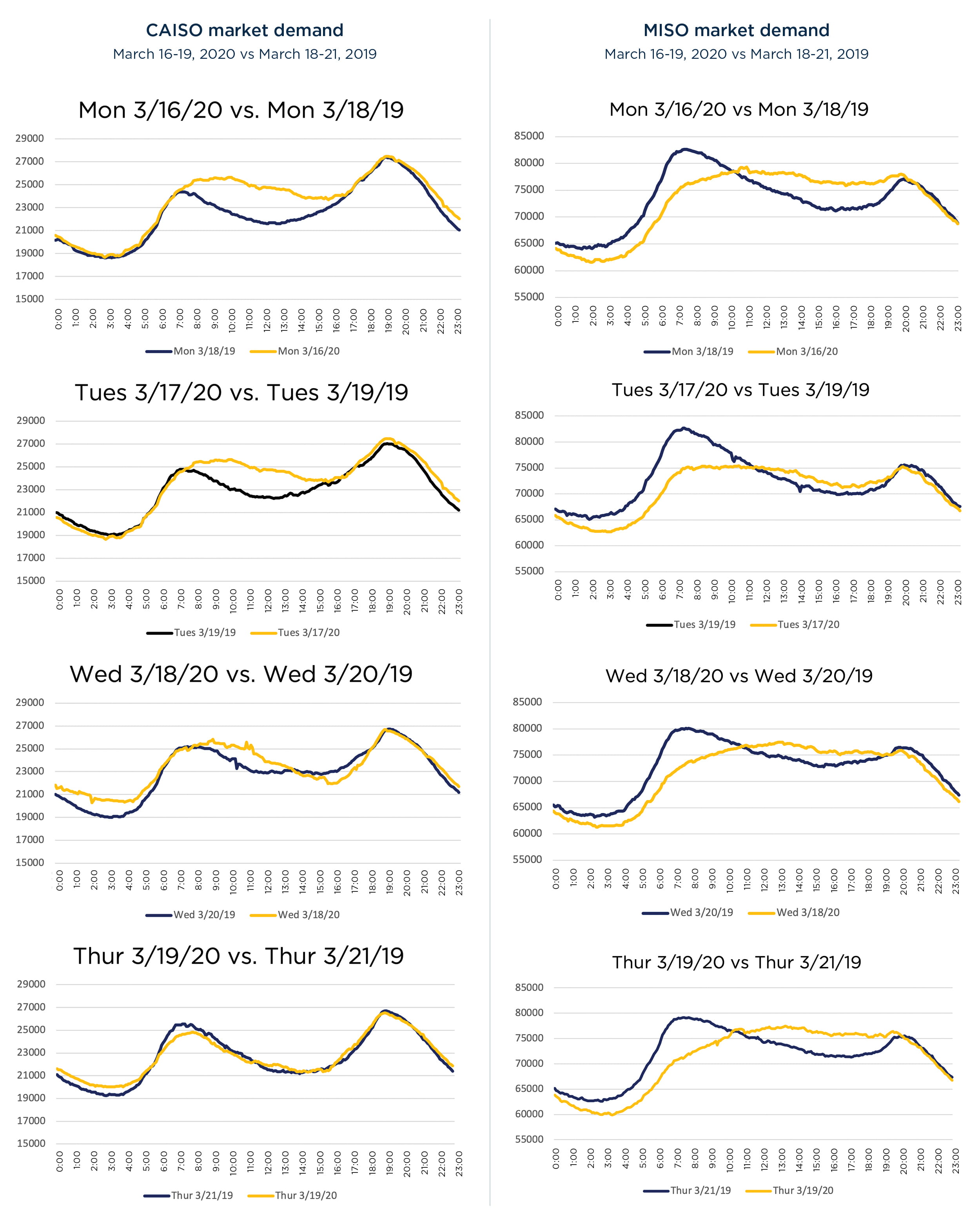
March 2020 | Point of View
The impact of COVID-19 on U.S. utility operations
Mitigating risks and shifting operations in a rapidly changing environment
The impact of COVID-19 on U.S. utility operations
Disaster preparedness for utilities has historically focused on readiness, restoration, and recovery. COVID-19 presents a unique and formidable challenge to utilities and society, as the likelihood of such events in the future becomes more top-of-mind. Utilities will need to include in their preparedness plans procedures for remote work. Continued customer access to customer care and call center personnel, and strategic communications and outreach is needed to ensure continued safe and reliable service to customers.
With the Coronavirus Aid, Relief, and Economic Security (CARES) Act passed on March 27, utilities have an opportunity to take steps to ensure safety and engagement of their workforce, ensure performance continuity, and deliver on the customer promise of safe and reliable service.
In this article, we outline techniques and methods that utility leaders can use to preserve employee knowledge and engagement, identify back-up skill sets for replacement continuity, and lay out some key risk mitigation strategies that can be put in place now to weather future COVID-19 type pandemics.
COVID-19’s Impacts on Utilities
West Monroe analyzed potential impacts beginning to emerge that utilities will need to address through the lens of grid operations, customer operations, workforce management, and financial management.
1. Grid Operations
Changing customer load profiles
Assessing the load changes from March 16-19, 2020 compared to the same week a year ago can provide some learning to utilities as conditions return more closely to a pre-COVID-19 state. Two key markets, CAISO and MISO, were analyzed by West Monroe to understand how load was distributed throughout the day last year (March 18-22, 2019) and during quarantine this year, given conditions were similar seasonally.
CAISO and MISO market load curves in 2019, and during a similar period in 2020, when many states instituted “stay-at-home” request to slow the spread of COVID-19, are depicted below. The increase in electricity use during working hours was not as pronounced in MISO as it was in the CAISO market, though there was an increase nonetheless across all stay-at-home days.
While one week of data is not statistically significant or a large enough sample, it can serve as an indicator of future trends to be evaluated by utilities to better understand revenue and operational impacts that can result from changes in customer use and behavioral patterns.
Plant and system operations
Increased reliability expectations during COVID-19, to ensure the ability to serve stay-at-home residents and medical and emergency services facilities, puts additional emphasis on plant, infrastructure, and system operations. Variability in demand and supply will call for system operators and utilities to become hyper responsive and sensitive to abnormal use patterns, in this unprecedented environment.
2. Internal Operations
Workforce
Even before COVID-19, an increasing number of utility jobs were transitioning and able to be performed remotely. As more employees adapt to remote work in response to the pandemic, we might see larger numbers of employees to work remotely post COVID-19, defining a new normal. With larger segments of the workforce now split between remote and on-location, workers may experience lower levels of engagement – leading to an impact in knowledge transfer and succession planning due to disruptions in the communal nature of on-location work.
Now is an ideal time to look at investing in digital workplace alternatives that make work, whether remote or on-site of in the field, more efficient and seamless.
Technology infrastructure readiness
Remote workforces and uncertain customers will demand higher availability of technology infrastructure to support IT backbone and CRM applications. Increased call volume on customer care centers for bill payments, LIHEAP (Low Income Home Energy Assistance Program) clarifications, increased issue reporting while operating care centers with limited employees would all require IT departments to be prepared for unplanned network and system outages.
3. Financial Management
Capital deployed and earnings impacts
Due to limited mobility during stay-at-home orders, delays may occur in the execution of capital projects, including IT and new construction programs. Process inefficiencies and reliance on paper and manual touchpoints for capital projects will hinder these projects further. If capital deployment is slowed it will directly impact service, and earnings which will also impact shareholder value. Cooperatives and public power could see higher costs for capital programs due to delay, unless digital and other remote work and process management strategies are employed to continue work during stay-at-home orders.
Revenue stability and cashflow
The decrease in realized revenue and cash flow due to delays in payment and increases in arrears could become a significant financial burden for utilities. As regulatory commissions and government agencies signal a need to maintain service to customers in arrears, utilities might start looking at investing in innovative approaches to engage customers to help them manage their usage and bills. Utilities could also look for ways to reduce the burden and complexity for enrolling customers in payment assistance or budget billing programs.
Mitigation Strategies to Weather COVID-19 Storm
To address the long-term impact of grid operations, workforce issues, delay in capital projects, and increasing arrears and reduced cashflow, utilities can take actions to continue delivering reliable service with high customer satisfaction, while also maintaining operational efficiencies.
1. Embrace digital technologies
Utilities have slowly been adopting digital strategies and technologies. Now is the opportunity to accelerate their digital capabilities with a focus on employee engagement and operational efficiency.
Tackling the employee digital workplace experience first allows utilities to transform the workforce more flexibly and responsibly. The digital workplace effort can apply to IT, front office, back office, and field operations. For instance, we helped one of clients develop an award-winning intranet site that brings more than 15,000 employees across several utility subsidiaries together in one place that promotes the company’s safety, engagement, operational excellence, and customer service goals.
2. Digital workplace to improve employee productivity
Digital enhancements and capital projects go together with productivity improvements. However, an often-missed opportunity is improvement in labor and process productivity (independent of technology). New digital programs are best started with a current-state analysis using tried and tested lean tools and methods to identify the different types of waste in any process and taking steps to eliminate it.
With a remote workforce, it becomes critical to have a streamlined process that relies less on paper-based trails and several levels of approvals to get a task done.
Lean analysis of key processes that heavily use manual and paper-based components such as new service requests, third-party pole attachments, solar and EV charging interconnection requests, and equipment scheduled maintenance processes are likely to lead to both short- and long-term productivity gains. A common lean tool that helps inform current state and identify wasteful steps in any process is a value stream map. Effective use of this tool can enable certain quick wins for the utility along with identification of longer-term initiatives. Robotic Process Automation is another tool that can effectively eliminate tedious, time-consuming, and manual processes and operations, improving service and saving money.
3. Other Revenue Enhancement Opportunities
Several utilities might be able to shift some of their capital dollars to certain strategic capital projects that could get started in the COVID-19 environment. This is a good time to invest in capital projects that enable future load growth such as Transportation Electrification and fiber telecommunications deployment. For utilities not allowed to own charging infrastructure, programs supporting electric vehicle purchases and charging can increase loads and improve the load factor while minimizing the increase in peak load. Today’s planning efforts can also support a longer-term investment in distribution network capital improvements needed to accommodate large-scale electrification deployment of fleets, buses, and residential vehicles.
Utilities may also benefit from exploring the feasibility of developing wholesale fiber, colocation of infrastructure with local ISP and 5G companies, commercial security lighting, and other non-commodity revenue opportunities. Investing now would position utilities for future load growth. These projects also serve as stimulus for the local economy because they can spur job creation and local economic growth.
4. Enhance Low-Income Programs and Payment Options
In the next six to eight months, utilities should be prepared for an increase in challenges stemming from customers’ inability to pay their bills and restrictions on utility’s ability to disconnect service to customers in need. Anticipating the higher-than-usual arrears, utilities should plan for enhancing their customer engagement by offering innovative payment arrangements, more advanced rate options (such as prepay and budget plans) and increasing access to low-income payment programs that will help financially impacted customers. Utilities should look to maximize the potential federal stimulus benefits for their customers who are seeing a higher utility cost burden.
5. Invest in Workforce and Continuity Planning
Utilities should start the process of cataloging job positions and developing a staffing metric that identifies replacement staff members for key positions. This ideally should be two levels deep in case key staff become ill. In addition, knowledge management technologies could be deployed to make it easier for the utility workforce to be cross trained quickly. Procedures could be developed to rapidly obtain workload status and identify key staff activities in preparing for stay-at-home scenarios or illness, in addition to and to complement investments in work-from-home technologies.
Developing a staffing response playbook which lays out a response strategy in the event significant portions of the workforce become unavailable is critical.
Unlike storm situations in which utilities can seek help from neighboring utilities, pandemics are global. Therefore, neighboring utilities will likely be unable to provide the resources necessary if they are equally impacted.
6. Data Driven Actionable Intelligence Dashboard
Given the rapidly changing environment, from the CARES Act to load changes to workforce planning, a dashboard view of the utility’s current operations is an immediate step that would help utility executives quickly get a pulse on the entirety of utility operations. As daily energy usage continues to change with more people working from home, executives will have a quick understanding of how this change in usage will impact future revenue forecasts, grid loading, and power purchases.
The dashboard combines this daily load impact information with other key performance indicators such as changes in on-time payments, number of customers enrolled in low-income programs, bad debt, customer satisfaction, call center performance, and employee engagement. The utility can then develop mitigation plans around each KPI that is moving in an unfavorable direction. These plans could include digitization of certain operations, productivity improvements, new revenue enhancing opportunities, enhanced payment assistance programs or updated business continuity plans.
Conclusion
The long-term impact of COVID-19 on utilities is yet to be known. There are some unique characteristics of the pandemic that makes it unlike any other economic event in recent history. Congress’s COVID-19 relief package (CARES Act) is the largest economic relief bill in U.S. history, allocating $2.2 trillion in support to individuals and businesses affected by the pandemic and economic downturn. This relief bill restricts utilities’ ability to disconnect customers and makes additional funds available for customer payment assistance through existing state administered low-income programs.
Utilities are wise to prepare for changes in customer expectations, load profiles, employee availability, and the ability to execute existing capital projects, all while ensuring reliability and a fair energy burden for all customers. Taking steps now to create a more digital workplace and improving the productivity of employees along with investing in low-income programs can help utilities meet the evolving expectations of their employees, customers, regulators, and owners.
Want to talk about COVID-19’s impact on your utility operations? We can help.



